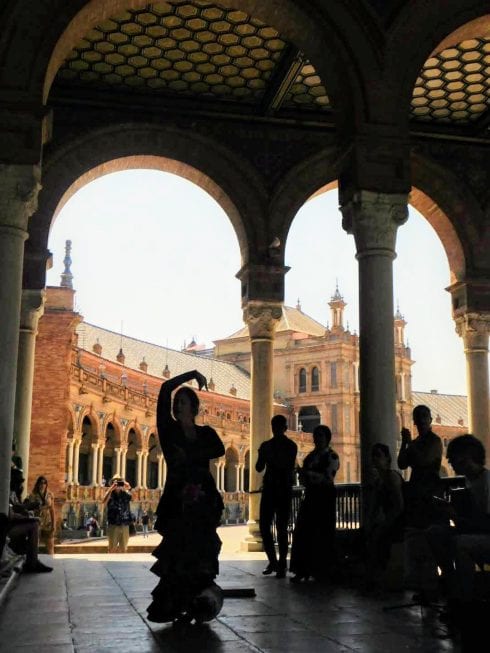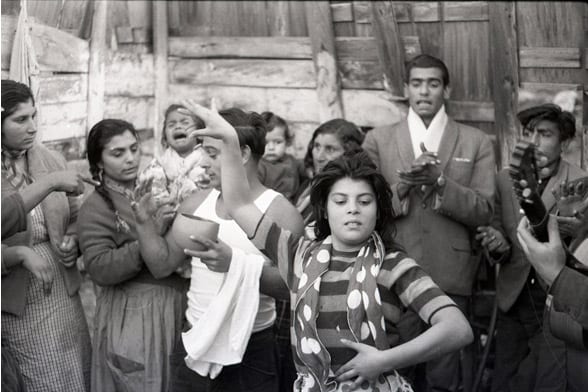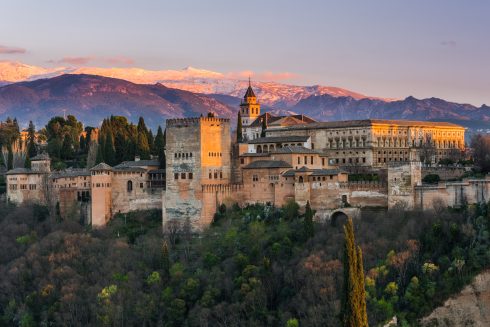WATCHING flamenco is stressful.
We are first lulled into the performance by the lone tocaor, or guitarist.
He sits on a red bulrush chair, one leg nonchalantly crossed, arms cocked at the ready.
Against the background of his all-black ensemble, the unadorned spruce wood guitar is the centerpiece.
And then he plays.
It begins as a slowly escalating picado, a measured yanking of metallic chords that builds and builds until it releases a tirade of machine-gun strumming.
His tapping foot and percussive fingers on the wood anchor the melody.

Soon he is joined by the cantaor, or singer. The balance shifts, the guitar becoming the foundation instead of the focus.
Floppy hair parted to frame his face in two quotation marks, a pearl earring dangling from his left ear, and a hirsute shadow covering his neck, the vocalist saunters in with poised confidence.
He finds an opening in the rhythm and begins to sing, cupped hands clapping along.
With undulant wails reminiscent of Islamic prayer calls, he sings of amor y desamor, love and heartbreak.
It is excruciatingly intimate. Like reading a diary you weren’t supposed to find.
As the music builds to a precipice, the balance shifts again and both performers cede the spotlight to the bailaora.
The dancer sweeps up her skirts, punctuating the music with the staccato of rapid-fire heels and slapping of thighs.
Sweat paints her face with streaks of blue eyeshadow.
She ends the act explosively; chest heaving, her breathing the only sound left.
A woman yells “Olé!” from the crowd.
It feels intrusive, almost voyeuristic, to watch her pained expressions on the stage.
But we can’t tear our eyes away.
The trio on stage at La Casa de la Guitarra perform six acts, each varied in mood, tempo, and technical style.
The evening begins with the guitarist, Manuel León, 39.
His 27 years of professional playing is evident from the first strum; the opening act is filled with nail-scraping picking, furious glissando and heavy-handed rasgueado.
Act two features the bulerías style, a rhythmic form unearthed from the shores of Cadiz.
León is joined by vocalist David de los Santos, 34.

At the duet’s close, dancer Yasaray Rodriguez, 44, enters for the first dance.
She winks before taking a seat, her shiny lipstick mirroring the stage-lights.
Rodriguez dances for two acts, a tarantas and an alegrias.
The performers rely on each other, improvising and reacting off of each other’s stylistic interpretations with raised eyebrows and head nods.
“She creates a drawing with her dance; I respond, and the singer responds as well,” explains León.
At La Casa de la Guitarra, pure flamenco rather than folklore andaluz is practiced.
Although reminiscent of the real thing, the latter has origins in ancient Andalucian tradition while the former encompasses a fusion of Arabic, Spanish and Gypsy culture.
The area known as the ‘flamenco triangle’ is made up of Sevilla, Cádiz and Jerez as its vertices.
Flamenco was borne out of the convivencia, a period of time in Islamic Spain when Muslims, Christians, and Jews lived peacefully.
Often referred to as the ‘Golden age of Spain’, it was a time in which knowledge and scholarship in architecture, writing and the arts was widely celebrated.
Theresa Goldbach, a dance expert from the University of New Mexico discusses the clear link between the dance and Francoist fascism during the early 20th century.
With the success of the 1917 Russian Revolution looming over Spain, the working class — many of them gitanos (gypsies) — was increasingly driven to protest.
During the heydey of Francoist Spain, flamenco was often used to call attention to important social issues plaguing Andalucian workers.
The struggles of regional miners were captured in the music and dance, an element still present today in certain styles.
According to León this is a key part of some pieces showcased at La Casa de la Guitarra.
“The taranta is dark because it reflects the pain and fatigue of the miners’ work with the coal,” he says.
Under Franco, flamenco was commercialized to promote Spanish identity and culture around the world.
Called nacionalflamenquismo, this technique was unfaithful to the true motivations of the dance, twisting it into propaganda.
Goldbach explains that the original lyrics praising the gitano culture were temporarily modified by performers to avoid persecution.
According to her research, songs could never be officially censored by the regime because they are traditionally passed down, slightly changing with each interpretation.

Flamenco is also highly improvisational, making it difficult to find an accurate record of what was sung in the past.
While the lyrics paint the narrative, a flamenco dancer’s dress is an equally integral part of the storytelling in a performance.
“These dresses are made for dancing,” León said. “They are cut so that when she raises her arms, the dress doesn’t rise with her.”
“Every dance style also has its own distinct dress,” he added. “For example, la solea is about love and heartache so the colours are a darker, passionate red.
For alegrias, which are more joyful, we use brighter colours: pink, green, white.”
Within the narrow streets of Sevilla is Bordados Foronda, one of several artisan workshops that are dedicated to hand-crafting flamenco dresses.
Inside the workshop are reams of fabric: satin, cotton, crepe, plumeti.
Rich shawls in burgundy, black, and deep blue hang on the walls, embroidered with silky flowers or polka dots.
Mannequins are proudly draped in the dresses, and display cases are bedecked with handmade fans showcasing the art of Joaquín Sorolla, chunky earrings, and hair clips.
The owner of the shop, Francisco, is a mild-mannered man affectionately known as Paco (‘o Paquito, o Fran, lo que tu quieras’).
Standing among the rolls of fabric stacked around his workshop, he speaks rapidly, flying hands expertly differentiating between types of fabric.
The workshop has dressmakers with up to 40 years of experience, making it a favourite with Sevillanos purchasing dresses for ferias, festivals and weddings.
“First and foremost, one must respect the woman’s form,” Paco said, explaining how the workshop customises dresses to suit each client.
“After that, you can either make it simple or more colourful, depending on the customer’s preferences.”
But during the performance, it is not the dress that makes the woman but the woman who makes the dress.

On stage, Yasaray Rodriguez fills the space with her messianic zeal and malleable expressions, seemingly out of reach.
Off stage, standing at 150 centimetres tall, she is about a head shorter than us.
What she lacks in verticality, however, she makes up for in personality.
Hailing from Havana, Cuba, Rodriguez was only 11 when she stumbled upon the hobby that would come to define her life.
Five years later, she auditioned for the Cuban National Ballet under the helm of its prima ballerina director Alicia Alonso.
Although lacking in thorough training at the time, Rodriguez attributes her success during the audition to ‘circumstances and attitude’.
Her face and hands are wildly animated when telling the story of her audition, how she improvised and used her cheeky charisma to perform where her technical knowledge faltered, capturing the attention of the Spanish director.
Despite having just finished an hour-long performance, she cannot help but stand up to act out the memory, throwing her head up in a laughing pantomime.
Rodriguez danced and toured with the ballet company for a decade. By the age of 25, she had acquired a repertoire spanning classical ballet, flamenco, salsa, and various other Cuban dances.
“It was time for me to find out what it was about flamenco’s essence that drew me in more than any other dance,” she said.
Getting to Spain was key in understanding this inexorable passion.
She left Cuba for Sevilla, where she was granted a full scholarship by the Cristina Heeren Foundation to study flamenco.
The cultural permit provided by the Cuban Ministry of Culture was originally for three months. Rodriguez quickly contacted them in an attempt to lengthen it.

But when the request was passed on to the Ministry of the Interior she was told to ‘return immediately to Cuba or be marked a deserter’.
Had she returned to the island, Cuba’s communist regime would have punished her for two years — an eternity in a dancer’s career.
Now 44 years old, Rodriguez has stayed in Sevilla since, making a name for herself as a bailaora with worldwide renown.
She has trained under a dozen dance veterans – Milagros Mengibar and Carmen Ledesma to name but two – and performed at festivals throughout Spain, France, Germany, Brussels, Morocco and Moscow, winning awards at national competitions.
For Rodriguez, however, flamenco is much more than simply a performance or even a career.
“It’s like when you fall in love, literally, you feel butterflies in your stomach,” she says with a dreamy sigh.
Te impulsa. Te tiene que levantar.
“It propels you. It has to raise you up.”









